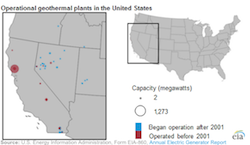 California has been the leading geothermal energy state in the U.S. but according to a recent Today in Energy published by the Energy Information Administration (EIA) other western states are slowing adopting geothermal energy.
California has been the leading geothermal energy state in the U.S. but according to a recent Today in Energy published by the Energy Information Administration (EIA) other western states are slowing adopting geothermal energy.
There are currently 64 operating conventional geothermal power plants in the U.S., accounting for nearly 2,700 megawatts (MW) of total capacity at the end of 2013 or 0.4 percent of total U.S. generation. Over three-fourths of U.S. geothermal power generation in 2013 was in California, largely because of favorable geothermal resources, policy, and market conditions in the state, according to Today in Energy. The largest group of geothermal power plants in the world, a complex called the Geysers, located in Northern California, has more than 700 MW of capacity.
Since 2001, only 7 of 30 new plants exceeding 1 MW have been built in California, where most available low-cost geothermal resources have previously been developed. Sixteen of those 30 plants built after 2001 are in Nevada, with the remainder in Oregon, Idaho, Utah, and Hawaii. Most of the newer plants are relatively small, and while geothermal generation rose 11% between 2008 and 2013, the geothermal share of total U.S. electricity generation has remained consistently around 0.4% since 2001.
Geothermal plants are virtually emissions free, and unlike renewable sources such as wind and solar, they provide an available, dispatchable source of baseload power that is able to operate at a relatively high capacity factor. EIA projects that geothermal electricity generation could more than quadruple between 2012 and 2040 (increasing to over 67,000 GWh), helping California and other states with renewable portfolio standards satisfy their mandated renewable generation requirements.

